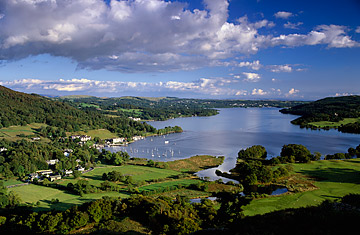
A view of Lake Windermere and Waterhead Bay in Ambleside, UK.
Scientists have made lots of projections over the past few years about how warming temperatures and a changing climate will affect the planet. Real-world measurements have confirmed at least some of them: sea level is clearly rising, for instance, and the ice that covers the Arctic Ocean is shrinking and thinning — in the latter case, faster than anyone had expected just a few years ago.
Other measurements are a lot more difficult, though. It's reasonable to expect, for example, that ecosystems will change as plants and animals respond to a rising thermometer — but how do you measure the change of an ecosystem that may consist of hundreds or even thousands of species?
The answer, evident in a paper just published in the journal Global Change Biology, is that it isn't easy — but it's possible nevertheless. A team of scientists led by Stephen Thackeray, an expert on lake ecology at the United Kingdom's Centre for Ecology and Hydrology, has combed through observations of more than 700 species of fish, birds, mammals, insects, amphibians, plankton and a wide variety of plants across the U.K. taken between 1976 and 2005, and found a consistent trend: more than 80% of "biological events" — including flowering of plants, ovulation among mammals and migration of birds — are coming earlier today than they were in the 1970s.
On average, these events are occurring about 11 days earlier, and the pace of change has been accelerating with every decade. "The pattern is very similar," says Thackeray, "whether you look at marine or freshwater or terrestrial organisms."
But differences in the pattern emerged when scientists looked at species at different levels of the food chain. As part of the analysis, says Thackeray, "we grouped these trends according to organisms' positions." What they found was that the changes in biological events were greater toward the bottom of the food chain than they were at the top.
In theory, that could prove to be a serious problem. In some cases, predators will be able to adapt to changes in their prey. In others, however, maybe not. A 2006 study in Nature, for example, documented plummeting populations of a bird called the pied flycatcher in the Netherlands. The reason: an earlier spring was speeding up the emergence of caterpillars that were the birds' staple. But because the flycatchers' were leaving their wintering grounds in West Africa at the regular time, their eggs were now hatching in the Netherlands too late in the season, after the caterpillars were nearly gone.
Thackeray is too careful a scientist to speculate about whether that sort of disconnect lies in the future for U.K. species. "I want to be very careful to talk only about what we've formally tested. My feeling is that the impact will vary, but I can't say more," he says. He's even too cautious to state that these changes are necessarily evidence of global warming. "The patterns are coherent across different habitats," he says, "which would suggest a large-scale phenomenon. It would be tempting to conclude that this might be a change in climate. But we need to do further study before we can draw that conclusion, and we have to be rigorous and unbiased."
Nevertheless, biologists have been suggesting for years that species across the board are likely to come under some metaphorical heat as the actual temperature rises — and this new and exhaustive piece of research is at the very least perfectly consistent with those predictions.
Lemonick is the senior science writer at Climate Central.
